The Wellesley Effect in London
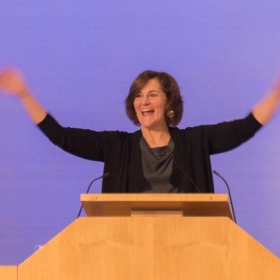

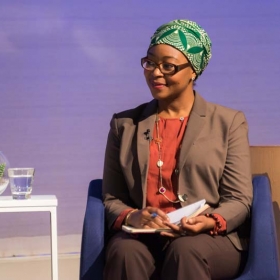

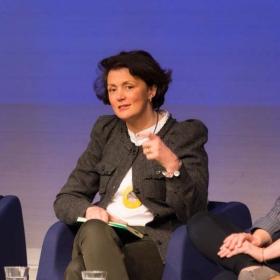


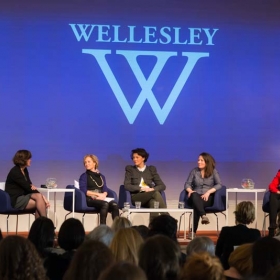


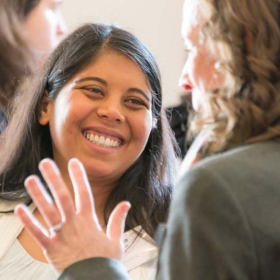
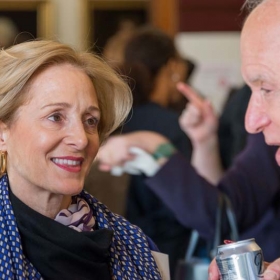




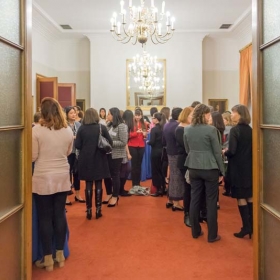
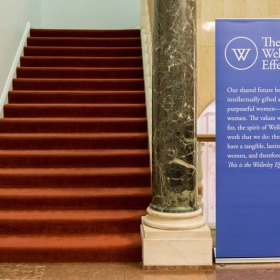
In a challenging era, President H. Kim Bottomly brought calm leadership and a global vision to Wellesley College.
In a challenging era, President H. Kim Bottomly brought calm leadership and a global vision to Wellesley College.

In 2007, when H. Kim Bottomly began her work as Wellesley’s 13th president, she told a story about her childhood in rugged, rural Montana. In its open spaces, she built forts, learned to fish, and roamed the outdoors on her own — but also discovered the importance of relying on others.
“We lived on a Blackfoot Indian reservation,” recalls Bottomly, whose parents were teachers. “It’s bitterly, bitterly cold there, and in the winter they’d often have fierce blizzards—but you’d always go to school. There was a large rope strung from the middle of town to the school door, and you’d follow the rope to the school. And you had to hold on, because if you let go, you got disoriented. You would wander off, and nobody could find you.”
Hanging on to that “life rope” was literally a matter of survival for those Montana schoolchildren. Now, as she reflects on her nine-year tenure at the College, Bottomly says she chose that story as a metaphor for how she would look to the Wellesley community, and senior staff in particular, to be her life rope.
And so she has. “There are a lot of things I love about Wellesley,” Bottomly says. “But the thing I love most about Wellesley is the people. It’s a very unusual community. People are kind. They probably all can recite the mission by heart. They understand what we do, and they give a lot of time and effort and wisdom to helping the place. And that’s also true of alumnae. I’ve never met alums who are so absolutely caring about a college.”
Bottomly also has relished her contact with students—even if they’re disagreeing. “The students are great. Sometimes they’re strident—but you know, I like strident. They’re in a hurry. They want to get things done. You can tell them as much as you want, ‘Well, these things take time.’ They don’t get that. And I love the fact that they just want what they want nevertheless, and they don’t give up. Put that together with being very smart, and they have really good rationales for the things they believe in. That’s been very enjoyable for me.”
Bottomly came to Wellesley in August 2007, at a time of hope and high yields in the stock market. Within a year, the market declined precipitously and the College’s endowment—along with those of Wellesley’s peer institutions—took a huge hit. Bottomly found herself presiding over an era of unexpected austerity.
Yet the president has seen many successes. (See “Landmarks of Leadership,” below.) She’s proud of the establishment of the Albright Institute for Global Affairs and formalized partnerships with Olin and Babson as well as universities abroad. Other accomplishments are the launch of an ambitious capital campaign and the new College to Career (C2C) initiative, which will reimagine Wellesley’s career service function.
Bottomly also points to significant campus renewal, Wellesley’s recommitment to its role as a women’s college and the new gender policy concerning admissions, and the establishment of the Presidential Commission on Ethnicity, Race, and Equity, which reflects the College’s deep commitment to diversity, as hallmarks of her time here.
But remember that life rope? As it turned out, Bottomly would need to hang on to it sooner than anyone imagined, as the blizzard of the 2008 economic crisis swirled around the country—and the College.
[supporting-images]
Bottomly was inaugurated in May 2008; that fall, Lehman Brothers collapsed, spiraling the nation into the Great Recession—and hammering the endowments at most American colleges, including Wellesley. “The economic crisis, which I had no control over, really made it necessary for me as a president to think about the sustainability of our financial model. I think that one of my contributions [has been] making sure that we came out the other side as the strong place that we are,” she says.
For guidance and support, Bottomly turned to the College’s economics faculty, the board’s finance committee leadership, alumnae, and her senior staff. And Andrew Shennan, provost and dean of the College, was at her side through it all.
“Kim came to Wellesley at the end of a very successful campaign, a run-up in the economy, a run-up in the endowment, a period of adding to programs,” Shennan says. “Almost immediately, she was hit by the financial crisis, and everything that flowed from that. But enduring institutions have a knack for having the right kind of person for the times in which they’re living. I think [Kim] has been the right kind of leader for the times that we have been through, because I think that we have appropriately reassessed our financial operations and our campus. And none of that has been easy.”
As the crisis unfolded, Wellesley took swift action, aiming to spread the negative impact of a significant operating-budget shortfall across several years. The College workforce was reduced through painful layoffs, departments were reorganized, operating budgets cut, and faculty and staff salaries frozen. Even as these and other austerity measures took effect, the College remained committed to need-blind admissions.
“The next few years will be difficult. They will be difficult everywhere, not just at Wellesley,” Bottomly told the community in 2009. But, “I am confident that we will emerge from them even stronger—not as just as an institution, but as a community, as well.”
Kathryn Lynch, dean of faculty affairs, recalls of that difficult time, “Despite the pressure, [Bottomly] met the financial crisis with the customary calmness and thoughtfulness that would become her signature quality—but she also acted swiftly and aggressively to bring our budget into balance. Her response was extraordinary, and reflected the unique Kim Bottomly recipe: not to overreact but to act firmly, swiftly, and appropriately.”
“I’m a listener,” Bottomly says. “I think some people think I’m a little too quiet when they talk to me, but I like to hear their ideas. I’ve always believed really strongly in collaboration. I like to be consultative. I like to hear the ideas that come from different people in different constituencies. And yet, at some point, I have to make decisions.”
Much was made of the fact that Bottomly would be the first scientist to lead Wellesley when she was selected for the presidency. Her leadership style had indeed been shaped by her experience as an immunobiologist heading a research laboratory at Yale.
‘Being president of a college is one of the more difficult things that one could do. Kim has really delivered in terms of dealing with some very difficult subjects. And this is not an easy time anywhere, on any campus. But I think she’s been a very good president, and I think that she deserves a lot of credit for having gotten Wellesley through various times where there were financial issues, and some social issues, and a variety of challenges. I keep thinking about her calmness. She’s a centered person.’
“Presidents, like scientists, have to solve problems for which there is little precedent,” she says. “My personal leadership style was tested in a laboratory. Science is an inherently cooperative enterprise—it’s the only way it works. Listening to the ideas of departments, academic planning committees, and working groups and nurturing good ideas was second nature to me as a scientist. It helped me to take advantage and actualize the expertise in this community.”
The members of Wellesley’s senior staff, says Bottomly, are “the best thinkers I’ve ever met. All are really good divisional leaders. They know the part of the College they need to run, and they’re thoughtful about it. Yet they can come together as a group and put away that hat and just say, ‘What’s best for the institution?’ in a really unselfish way.”
Cameran Lougy Mason ’84, vice president of resources and public affairs, has been part of that circle. “Kim is very open to feedback,” she says. “She really listens, really takes what you say to heart. She will change her mind if you feel strongly and can argue it—she is not wedded to one thing. She is not the kind of leader who says, ‘This is my vision—you guys go implement it.’ She works with the senior team as one of them to help create a direction and a strategy. She is also very pragmatic and data-driven. I think she is good at seeing things from above, like a chess game, recognizing all the steps you have to take to get somewhere.”
Bottomly’s approach to problem-solving means that she sees the inevitable challenges that crop up on a campus as opportunities, says Sidney Knafel, trustee emeritus. Each such challenge, he says, “would invariably entail a teaching/learning experience that required analysis, clarity, and an ad hoc or in-resident group consideration of that data. The institution typically ended up much strengthened by this process and its conclusions.”
In 2014, responding to student discomfort over Tony Matelli’s Sleepwalker figure offered one such opportunity. “The Sleepwalker sculpture debate was about artistic freedom of expression pitted against individual discomfort,” Bottomly says. The sculpture, of a realistic, sleepwalking man dressed in only his underwear, caused controversy on campus when some students argued that the piece undermined their sense of safety, triggering associations with sexual assault.
In response, Bottomly met with students, faculty, staff, and administrators to address the issue and formed a working group of individuals from those constituencies to advise her. The group, she wrote to the College community at the time, “talked about the ways in which education, by design, introduces ideas that disturb, and the fact that learning is often accompanied by a disruption of personal perspective. We talked at length about ‘triggering’ … . We talked about academic and artistic freedom—and free speech.”
Later, Bottomly wrote with her decision about how to move forward: “I have come to two conclusions: We cannot destroy the artistic integrity of this exhibition by moving the sculpture, and also, we must do everything we can to support those students who find themselves deeply affected by it.”
The controversy spilled into social media and thence to the national press. A Wall Street Journal writer opined that Wellesley women just needed to “man up.”
Bottomly wrote to the paper in no uncertain terms: “The presence of the Sleepwalker sculpture at Wellesley has raised many important questions about art, feminism, freedom, and censorship. … At Wellesley, we stand strong for academic freedom, and for our tradition of activism steeped in the liberal arts. … I am proud to be part of a community where women feel free to argue for what they believe in—and one that has a long history of just that. And I am proud of our strong, bright women—whichever side of this issue they espouse. None of them have any need to man up, and I hope and trust, for women’s sake, that none of them will ever shut up.”
Katherine Collins ’90, founder and CEO of Honeybee Capital, was a member of the Alumnae Association board at the time. “I am proud that Wellesley has always chosen leaders who speak out with clarity and conviction,” she says. “I love that our president distinguished between legitimate, important artistic debate and the attempt to discount or silence women’s voices. I love that she called out the Wall Street Journal on their coverage. I love that she unequivocally defended our students’ right to be heard and respected. I love that in doing so, she embodied the best that Wellesley has to offer the world: thoughtful, focused, vocal engagement in the most crucial issues of our time.”
[substory:1]
Cameran Mason says Bottomly “gave shape to our global aspirations” through her commitment to a wider vision of the world and Wellesley’s place in it. During her presidency, the College launced initiatives aimed at advancing Wellesley as a global resource and leading authority on women’s education and leadership. A partnership with Peking University in Beijing brought a Wellesley-sponsored conference on women’s leadership in China three years ago, and a partnership with Ashoka University in Haryana, India, was signed this spring. But Bottomly is particularly proud of the Madeleine Korbel Albright Institute for Global Affairs.
The College launched the Albright Institute in January 2010, drawing on faculty from across the liberal-arts disciplines and outside experts in fields ranging from government to social entrepreneurship. “The whole idea [for the institute] was to have an approach that was cross-disciplinary, that was based on team experience, and was innovative,” Bottomly says. “We wanted to make sure that the students weren’t just learning about the world, but were really learning how to be leaders in that world.”
During the annual institute, the 40 fellows—selected through a rigorous application process—tackle global problems and craft ideas for solving them. The model “encourages an exchange of ideas among a very diverse group of people,” says Bottomly. “You have the students, the faculty, the policymakers, you have world leaders in global areas. And they all have to talk to each other and figure out things in relationship to a problem. It’s not just the same old classroom experience.” (See page 8 for more on the institute.)
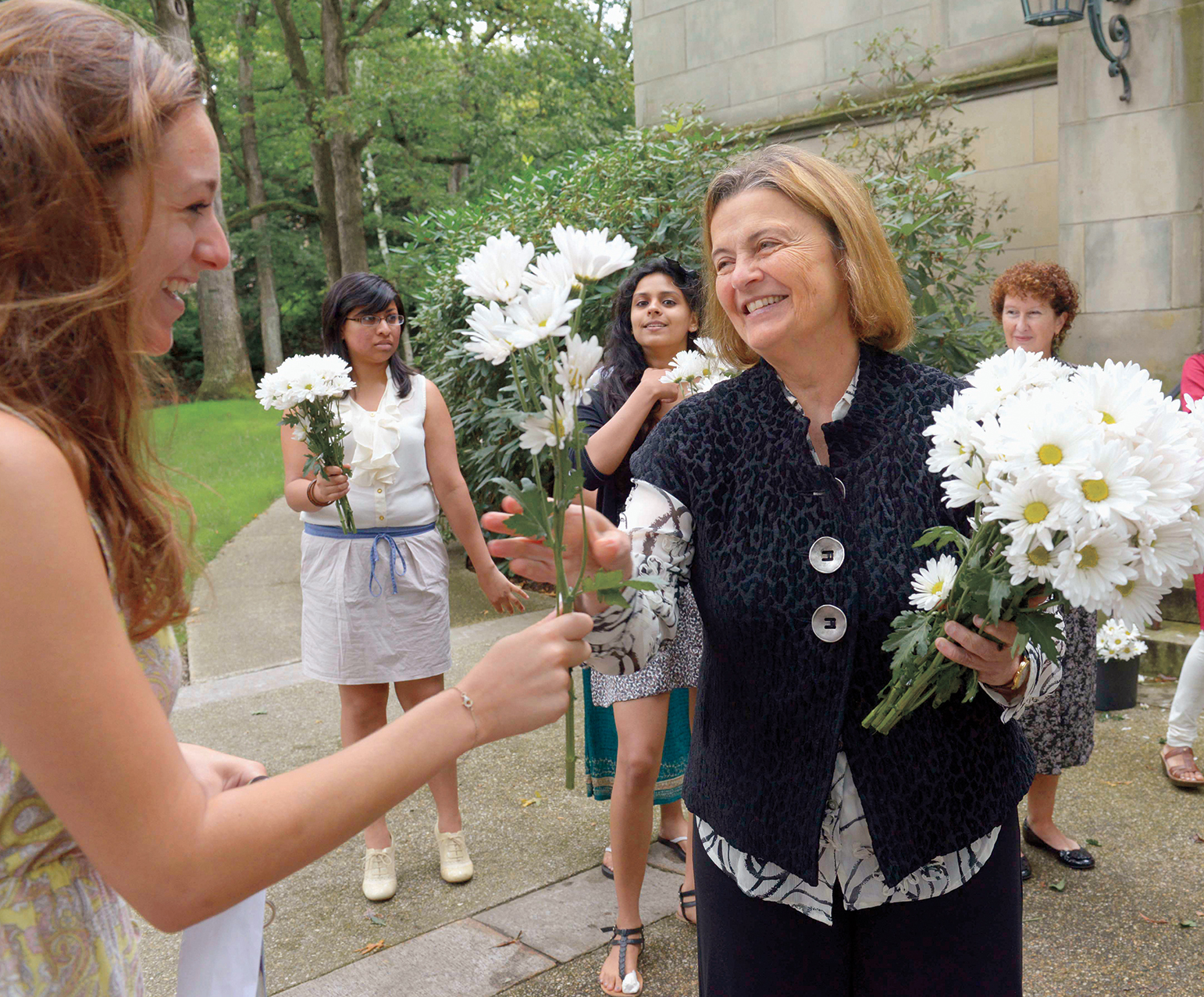
‘When I think about Kim, I think of her analytical intelligence, her courage and strength, and her willingness to try new things, even when those things might not be easy or comfortable for her. I also think of her warm smile and laugh, which often disarmed the listener, who may have just heard something he or she didn’t want to hear. I have always had this mental image of Kim as a woman of [Montana]—strong, bright as hell, fearless, firm, and feminine. We are blessed to have had her serve as our president for the past nine years.’
Joseph Joyce, M. Margaret Ball Professor of International Relations and professor of economics, was faculty director of the institute at its inception. He says that it took courage for Bottomly to commit to its launch. “From my perspective, [her] support during the early days in 2008 and 2009, when the economic downturn threatened the financial standing of the College, was crucial. She allowed us to establish the institute and arrange its first program in 2010. During periods of stress, beginning with the economic crisis and in subsequent years, Kim was a composed and calm presence, listening carefully to the views presented by faculty, staff, and students. She valued collaboration, dialogue, and conflict resolution.”
Bottomly says, “I think the expanded global focus—and especially the institute—will be part of my legacy. We already have some 270 Albright Fellow alums. Think of the impact on the world when there are thousands of them! The idea of what they could do in this world really gives me goose bumps.”
Any visitor to campus this year has seen the impact of the College’s commitment to campus renewal in the busy construction site that is Pendleton West, which is being transformed into a state-of-the-art center for the creative arts with a 10,000-square-foot addition for rehearsal and performance space. Just as important have been the renovations of Schneider (now a center for student services), the Dorothy Towne Field House (including a new fitness center), and the Butler Boathouse.
Up next: renovating Acorns, formerly the dean of students’ house, as a new home for intercultural education advisors and the students they serve—part of a renewed commitment to create a network of multicultural spaces on campus. Harambee House, which has served students of African descent since 1970, will also be repaired and upgraded. Plans are in the works for a major Science Center renovation and a new greenhouse. Renovating and refreshing common spaces in the College’s residence halls is a priority for the current campaign, beginning this summer with Freeman.
“I’m particularly proud of campus renewal,” Bottomly says. “The previous administration and the trustees really set the stage. It was clear to me that we needed spaces that support our ambitions for learning, living, and discovery. Our excellence depends fundamentally on the spaces we inhabit. So I think the fact that we’ve developed a multiyear plan, and have a financial model to go along with it, really says that it’s a high priority of the College.”
Bottomly says she has taken great pleasure in watching the work get done on Pendleton West during her last winter on campus. “There’s nothing better than seeing a building almost done, because of all the angst of getting there. And when you see the finished building, you just want to kind of wallow in it for a while,” she says.
Bottomly admits that being a college president has been a formidably demanding job of 12-plus-hour days. “I’m very detail-oriented, and intensely into my work,” she says. “So I do have to get away from it every once in a while, otherwise you just burn out.”
She relaxes by taking vacations with her family—although even those are active. “I usually try to do the kind of a vacation where you have to perform. In other words, you’re not just totally relaxed. Sometimes I go hiking, or sometimes I go to a different country. Whatever it is, I have to focus on the daily thing, because it requires my attention, which makes me not focus on my work at Wellesley.

‘She has, along with the deans, committed the College to addressing and fostering diversity in its widest and fullest meanings, insisting on civil engagement with different points of views about often difficult issues both within and beyond the College. I commend her for her consistent leadership in this regard.’
“I need to disconnect. And the easiest way for me is just spending time with my family. We love being together, and so it’s very nice. I always say there’s nothing that a good cup of coffee or a glass of wine can’t fix.”
Bottomly’s husband, Wayne Villemez, is a retired academic. “He’s a sociologist,” Bottomly says. “He’s calmer than I am, believe it or not. He’s willing to listen. He’s unflappable.” One of her daughters is a pediatric oncologist, another a medical resident in surgery, the third a resident in emergency medicine.
“So three daughters, three doctors,” she laughs. “I said, ‘You, know, it would really be helpful if we had a lawyer or an investment banker. Or if one of you went into geriatrics.’”
Bottomly and Villemez aren’t sure what comes after Wellesley, though they are excited to have purchased a small condo in the South End of Boston. But she says she will miss Wellesley—“the people, the beautiful campus, my enviable walk to work, meeting and getting to know many interesting and smart people.”
Looking out her office window at the campus below, she adds, “When you try to sum up [a presidency], to say one thing, what would that be? And I would have to say that I really focused on maintaining Wellesley’s excellence. Durant didn’t want Wellesley to be just some school for women to learn how to sit and sew. He was serious about it. He wanted women to have an intellectual experience. Having a history of 13 presidents, including me, focused on that really mattered.”
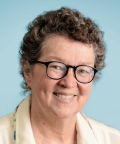 Catherine O’Neill Grace is a senior associate editor of Wellesley magazine.
Catherine O’Neill Grace is a senior associate editor of Wellesley magazine.

















